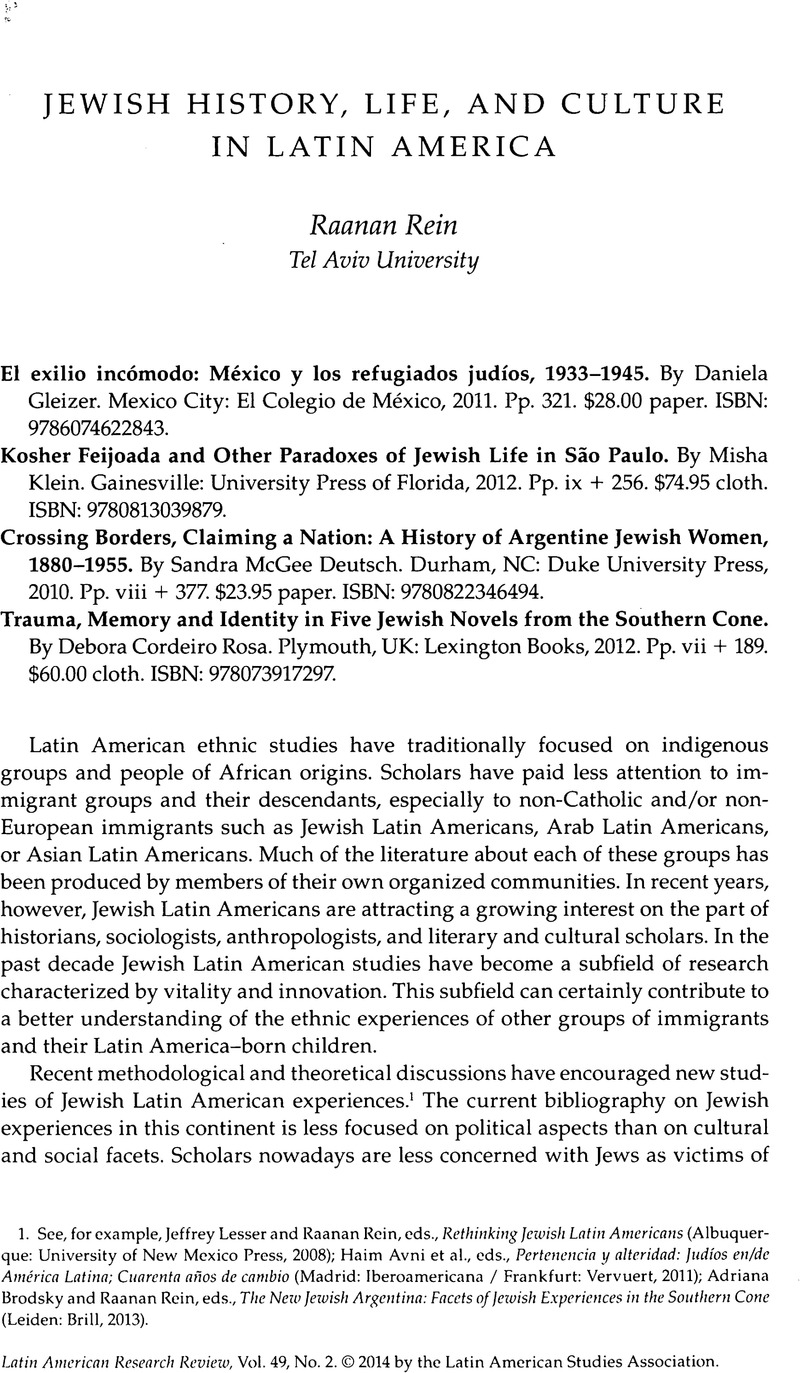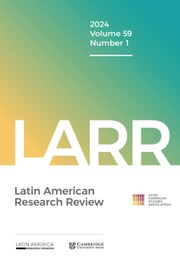Article contents
Jewish History, Life, and Culture in Latin America
Review products
Published online by Cambridge University Press: 05 September 2022
Abstract

- Type
- Review Essays
- Information
- Copyright
- Copyright © 2014 by the Latin American Studies Association
References
1. See, for example, Jeffrey Lesser and Raanan Rein, eds., Rethinking Jewish Latin Americans (Albuquerque: University of New Mexico Press, 2008); Haim Avni et al., eds., Pertenencia y alteridad: Judíos en/de América Latina; Cuarenta años de cambio (Madrid: Iberoamericana / Frankfurt: Vervuert, 2011); Adriana Brodsky and Raanan Rein, eds., The New Jewish Argentina: Facets of Jewish Experiences in the Southern Cone (Leiden: Brill, 2013).
2. Leo Spitzer, Hotel Bolivia: The Culture of Memory in a Refuge from Nazism (New York: Hill and Wang, 1998); Allen Wells, Tropical Zion: General Trujillo, FDR, and the Jews of Sosúa (Durham, NC: Duke University Press, 2009); Eva Goldschmidt Wyman, Escaping Hitler: A Jewish Haven in Chile (Tuscaloosa: University of Alabama Press, 2013); Enrique Martínez-Ruiz, Haciendo comunidad, haciendo ciudad: Los judíos y el espacio urbano de Bogotá, 1920–1970 (Bogotá: Universidad Javeriana, in press).
3. Jeffrey Lesser, Welcoming the Undesirables: Brazil and the Jewish Question (Berkeley: University of California Press, 1994). The English edition of Gleizer's book has a somewhat similar title: Unwelcome Exiles: Mexico and the Jewish Refugees from Nazism, 1933–1945 (Leiden: Brill, 2013).
4. See, for example, Haim Avni, “Cárdenas, México y los refugiados, 1938–1940,” Estudios interdisciplinarios de América Latina y el Caribe 3, no. 1 (1992): 5–22; Judit Bokser Liwerant, “Alteridad en la historia y en la memoria: México y los refugiados judíos,” in Encuentro y alteridad: Vida y cultura judía en América Latina, ed. Judit Bokser Liwerant y Alicia Gojman de Backal (Mexico City: Universidad Nacional Autónoma de México and Fondo de Cultura Económica, 1999), 342–361.
5. See an earlier discussion of anti-Semitism and anti-Chinese attitudes in Alicia Gojman Backal, Camisas, escudos y desfiles militares: Los dorados y el antisemitismo en México, 1934–1940 (Mexico City: Escuela Nacional de Estudios Profesionales Acatlán (UNAM) and Fondo de Cultura Económica, 2000).
6. Recent important works on Mexico's immigration policies include Pablo Yankelevich, ed., Nación y extranjería (Mexico City: UNAM, 2009); Pablo Yankelevich, ed., México, país refugio: La experiencia de los exilios en el siglo XX (Mexico City: Instituto Nacional de Antropología e Historia; Plaza y Valdés, 2002); Katya Somohano y Pablo Yankelevich, eds., El refugio en México: Entre la historia y los desafíos contemporáneos (Mexico City: Comisión Mexicana de Ayuda a Refugiados and Secretaría de Gobernación, 2011).
7. Sandra McGee Deutsch, Las derechas: The Extreme Right in Argentina, Brazil, and Chile, 1890–1939 (Stanford, CA: Stanford University Press, 1999).
8. Berta Singerman, Mis dos vidas (Buenos Aires: Tres Tiempos, 1981).
9. Hasia R. Diner, Hungering for America: Italian, Irish, and Jewish Foodways in the Age of Migration (Cambridge, MA: Harvard University Press, 2009); Marcie Cohen Ferris, Matzoh Ball Gumbo: Culinary Tales of the Jewish South (Chapel Hill: University of North Carolina Press, 2005).
10. David William Foster, “The Jewish Presence in Latin America,” October 25, 2012, Oxford Bibliographies, http://www.oxfordbibliographies.com.
- 1
- Cited by


